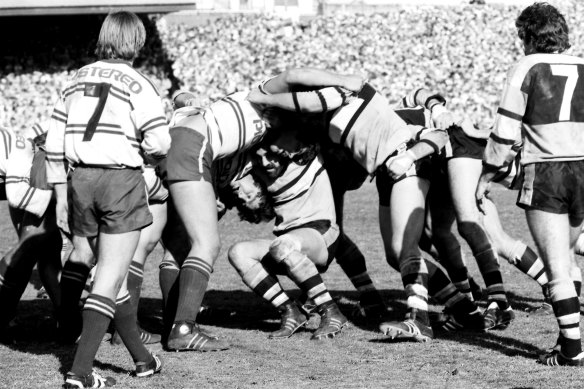By Roy Masters
The rule changes the NRL has made for the 2020 season are counter-productive.
Ex-players and coaches whine that the game has become too structured, too predictable, too rehearsed. It is about to become even more so.
Scrums can now be set at three points on the field – ten metres in from the sideline, the centre of the field, or the existing position of 20 metres in from touch, as it applies when a ball crosses the sideline. The change refers to all scrums, whether the ball has been fumbled, lost, or finds touch.

Those were the days . . . a scrum from the drawn grand final between Cronulla and Manly in 1978.Credit: Fairfax
Given the left and right structures of teams in the NRL today, it is likely that most coaches will instruct their captains to set the scrum in the middle of the field, then feeding the ball to their more preferred attacking side, or exploiting the opposition’s weaker defensive side. All teams know this before kick-off. So, with the ball at sideline stoppages moved to the centre, the game becomes even more of an up-the-middle contest.
The half of the NRL’s head coaches who attended a November meeting argued for these three starting points of scrums to promote “flexibility”. Because the team with the head and feed wins the ball 99% of the time, they believed these options would promote variety.
There is one single reason why we don’t see attack from scrums, and it has nothing to do with where it is set. Referees allow the defensive team to break too soon. Any planned move is extinguished by “back-rowers” (often the fullback) breaking prematurely and disrupting the attack.
Thirty years ago, coach Tim Sheens encouraged the rule makers to move scrums – which were then set ten metres from the sideline following a touch finding kick – a further ten metres infield. The resultant 20 metre corridor was designed to create more blindside attack. It hasn’t.
The solution is to abandon the differential penalty rule and allow kicks at goal from scrum breaches. Over forty years ago, fans protested that kicks for goal following scrums were boring. Well, is the current attack from scrums exciting?
There is one single reason why we don’t see attack from scrums, and it has nothing to do with where it is set.
The differential penalty rule was also introduced because some referees would threaten a team: “Do this again and I’ll get you under the sticks.” In other words, if a team deliberately breached at one end of the field, the referee would punish them for any one of about 30 possible scrum offences and award the opposition a kick at goal to win the match. Surely, NRL Central now has enough confidence in their referees to know none of them are cheats.
Under the new scrum set rule, the defence will be aware of the opposition captain’s preferred option. If the defence is ahead by two points and time is running out and it loses possession, its captain will order his tacklers to move to the anticipated scrum position.
The defensive back-rowers will then break early, gambling they won’t be penalised. If they are, the opposition can’t kick at goal. If they are penalised, the defence merely retreats, with its line straight and set. How much scintillating attack came from that?
The captain has five seconds to nominate the position where the scrum is set and in the early rounds there will be cases where his team engages in a committee meeting to decide where to set it.
Another rule change – the 20/40 rule - has the potential to create more variety in attack away from a team’s goal posts, rather than five one-out runs followed by a downfield kick.
Teams with clever dummy halves will be able to find touch in the opposition 40m zone and enjoy a repeat set. If the team has a clever No.7, he may exploit opposition wingers dropping back in anticipation of the kick and move the ball wide to his own unmarked flankers.
But players and coaches are notoriously regimented and it will take time for this rule change to have any effect.
Granting a captain’s challenge and allowing a repeat play following a mutual infringement do promote justice but they also extend the length of a game the NRL seeks to shorten.
What rugby league needs is more ad lib decision-making, yet, other than the 20/40 rule, these changes entrench structure and add time.
The NRL needs more mad scientists in what is increasingly becoming 25 rounds of eight matches played in a controlled laboratory.